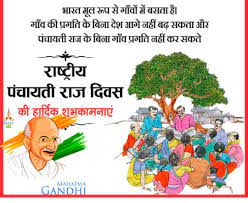26 Apr 2022 12th National Panchayati Raj Day

12th National Panchayati Raj Day – Today Current Affairs
- Recently 12th National Panchayati Raj Day was celebrated in the country on 24th April, 2022.
- The Prime Minister has started the Survey of Villages and Mapping with Improvised Technology in Village Areas (SWAMITVA) or distribution of e-Property Cards under Swamitva Scheme in rural areas with improvised technology.
Today Current Affairs
National Panchayati Raj Day:
Background:
- The first National Panchayati Raj Day was celebrated in the year 2010. Since then, National Panchayati Raj Day is celebrated every year on 24 April in India.
- This day marks the enactment of the 73rd Amendment to the Constitution in the year 1992.
Awards to be given on National Panchayati Raj Day : The Hindu Analysis
- Ministry of Panchayati Raj has been awarding best performing Panchayats/States/UTs across the country for their good work.
These awards are given under different categories : The Hindu Analysis
- Deen Dayal Upadhyay Panchayat Shaktikaran Award.
- Nanaji Deshmukh National Gaurav Gram Sabha Award.
- Child Accessible Gram Panchayat Award.
- Gram Panchayat Development Scheme Award.
- e-Panchayat Puraskar (given to States/UTs only).
Panchayati Raj : The Hindu Analysis
- Panchayats are mentioned in Article 40 of the Constitution of India and Article 246 empowers the State Legislature to make laws on any matter relating to local self-government.
- For the establishment of democracy at the local level, through the 73rd Constitutional Amendment Act, 1992, the Panchayati Raj Institution was given constitutional status and was entrusted with the task of rural development in the country.
- Panchayati Raj Institution is a system of Rural Local Self-government in India.
- Local self-government means the management of local affairs through bodies elected by the local people.
- To strengthen e-governance in Panchayati Raj Institutions (PRIs) across the country, Ministry of Panchayati Raj (MoPR) has launched a web-based portal e-Gram Swaraj.
- It integrates the planning, accounting and monitoring functions of Gram Panchayats. Its combination with Area Profiler Application, Local Government Directory (LGD) and Public Financial Management System (PFMS) enables easy reporting and tracking of activities of Gram Panchayat.
Salient Features of the 73rd Constitutional Amendment : The Hindu Analysis
- Part IX titled “Panchayats” was added to the Constitution by the 73rd Constitutional Amendment.
- Gram Sabhas (villages) were placed as the basic units of the democratic system consisting of all adult members registered as voters.
- A three-tier system of Panchayats has been implemented at the village, intermediate (Block/Taluka/Mandal) and district levels, except in those States whose population is less than 20 lakhs (Article 243B).
- The seats at all levels are to be filled by direct election [Article 243C(2)].
Reservation of Seats : The Hindu Analysis
- Reservation of seats has been done for Scheduled Castes (SC) and Scheduled Tribes (ST) and the posts of President of Panchayats at all levels have also been reserved on the basis of proportion of Scheduled Castes and Scheduled Tribes in the population.
- One-third of the total number of seats available are reserved for women.
- One-third of the posts of chairpersons at all levels are also reserved for women (Article 243D).
Tenure : The Hindu Analysis
- The tenure of Panchayats is fixed for five years but it can be dissolved even before the tenure.
- Fresh elections to Panchayats should be held within 6 months from the date of expiry of their tenure or the date of dissolution of Panchayat (Article 243E).
- There shall be independent election commissions in each state for the superintendence, direction and control of the electoral rolls (Article 243K).
- Powers of Panchayats: Panchayats are empowered to prepare plans for economic development and social justice in respect of the subjects mentioned in the Eleventh Schedule (Article 243G).
- Source of Revenue (Article 243H): The State Legislature may authorize Panchayats to:
- Budgetary allocation from state revenue.
- Part of the revenue of certain taxes.
- Collection and retention of revenue.
- Establishment of a Finance Commission in each State to determine the principles on the basis of which adequate financial resources shall be ensured for Panchayats and Municipalities (Article 243I).
Discount : The Hindu Analysis
- This Act is not applicable in Nagaland, Meghalaya and Mizoram and some other areas due to socio-cultural and administrative reasons. These areas include:
- Scheduled areas listed under the Fifth Schedule in the States of Andhra Pradesh, Bihar, Gujarat, Himachal Pradesh, Madhya Pradesh, Maharashtra, Odisha and Rajasthan.
- Hilly areas of Manipur for which district councils exist.
- Hilly areas of Darjeeling district in the state of West Bengal for which Darjeeling Gorkha Hill Council exists.
- However, Parliament has extended the provisions of Part IX and Fifth Schedule areas through the Provisions of the Panchayats (Extension to the Scheduled Areas) Act, 1996 [The Provisions of the Panchayats (Extension to the Scheduled Areas) Act-PESA].
- Presently 10 states (Andhra Pradesh, Chhattisgarh, Gujarat, Himachal Pradesh, Jharkhand, Madhya Pradesh, Maharashtra, Odisha, Rajasthan and Telangana) are included in the Fifth Schedule Area.


No Comments